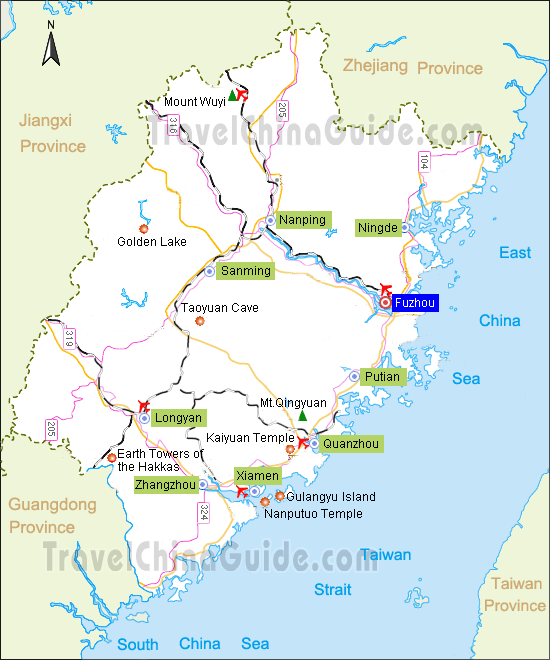Country China | Area 12,888 km2 | |
 | ||
University Zhangzhou Normal University | ||
Map of Zhangzhou
Zhangzhou, formerly romanized as Changchow, is a prefecture-level city in Fujian Province, China. The prefecture around the city proper comprises the southeast corner of the province, facing the Taiwan Strait and surrounding the prefecture of Xiamen. During the 2010 census, the entire area of Zhangzhou was home to 4,809,983 inhabitants. Along with the 1.9m people of central Xiamen, its urban districts of Longwen and Xiangcheng, together with Longhai, form a single metropolitan area of about 5 million people .
Contents
- Map of Zhangzhou
- Zhangzhou water village china
- Tieguanyin zhangzhou teaadventure wmv
- Name
- Geography
- Climate
- History
- Administrative divisions
- Demographics
- Economy
- Transportation
- Education
- Notable residents
- References

Zhangzhou water village china
Tieguanyin zhangzhou teaadventure wmv
Name

Zhangzhou is the atonal pinyin romanization of the city's Chinese name 漳州, using its pronunciation in Standard Mandarin. The name derives from the city's former status as the seat of the imperial Chinese Zhang Prefecture. The same name was romanized as "Changchow" on the Chinese Postal Map and Chang-chou in Wade-Giles. Other romanizations include Chang-chow.
It also appears as Chang-chu, Chiang-chiu, Chiang-chew, or Chiang Chew from the city's local Hokkien name Chiang-chiu. This name appeared in Spanish and Portuguese Jesuit sources as Chincheo, which was anglicized as Chinchew. By the 19th century, however, this name had migrated and was used to refer to Quanzhou, a separate port about 65 miles (105 km) east-northeast of central Zhangzhou.
Geography
Zhangzhou proper lies on the banks of the Jiulong River in southern Fujian about 35 miles (56 km) from central Xiamen, whose urban core has grown to form a single urbanized area with it. The prefecture of Zhangzhou comprises the southeastern corner of the province, surrounding Xiamen. The prefecture of Quanzhou lies to its northeast, Longyan to its northwest, and Shantou in Guangdong to its southwest.
Climate
Zhangzhou has a monsoon-influenced humid subtropical climate (Köppen Cfa), with mild to warm winters and long, very hot and humid summers. The monthly 24-hour average temperature ranges from 13.2 °C (55.8 °F) in January to 28.8 °C (83.8 °F) in July, and the annual mean is 21.3 °C (70.3 °F). The frost-free period lasts 330 days.
History
During the early Qing, Zhangzhou was the primary Fujianese port trading with Portuguese Macao and Spanish Manila. For a time, the Portuguese maintained a factory in the city.
During the late Qing, Zhangzhou remained a center of silk, brick, and sugar production with about a million people and extensive internal and maritime trade. Its city wall had a circumference of about 4.5 miles (7.2 km) but included a good deal of open ground and farmland. Its streets were paved with granite but badly maintained. The 800-foot (240 m) bridge across the Jiulong River consisted of wooden planks laid between 25 piles of stones at roughly equal intervals. The port of Xiamen in an island at the mouth of the Jiulong principally functioned as a trading center for the produce and wares of Zhangzhou and its hinterland; both suffered economically when Indian tea plantations cratered demand for Fujianese tea in the late 19th century.
The old city of Zhangzhou (now Xiangcheng District) was occupied in April and May 1932 by a column of Communist guerrillas under Mao Zedong. Due to the presence of Western gunboats in Xiamen Bay, arms shipments from the Soviet Union were unable to get up the Jiulong River to Mao's forces and the main Communist bases. Discovering this, Mao retreated from the city, according to some accounts with a substantial amount of loot taken from its residents.
Administrative divisions
Zhangzhou comprises 2 urban districts, 1 county-level city, and 8 counties.
- Xiangcheng District (芗城区)
- Longwen District (龙文区)
- Longhai City (龙海市)
- Changtai County (长泰县)
- Dongshan County (东山县)
- Hua'an County (华安县)
- Nanjing County (南靖县)
- Pinghe County (平和县)
- Yunxiao County (云霄县)
- Zhangpu County (漳浦县)
- Zhao'an County (诏安县)
Demographics
The main language of the Zhangzhounese is the local dialect of Hokkien, part of the Southern Min branch of Min Chinese. Government, education, and official business, however, are carried out in Mandarin.
Economy
Babao seal paste was invented by the druggist Wei Changan as a traditional medicine in 1673. It was repurposed for artistic use a few years later and gained imperial favor under the Qianlong Emperor. It remains prized for its bright color and pleasant smell.
A major petrochemical plant, producing paraxylene, owned by Taiwan-based Xianglu Group is located in Zhangzhou's Gulei Peninsula. The plant suffered major fires in 2013 and 2015.
Transportation
Two passenger stations serve Zhangzhou:
